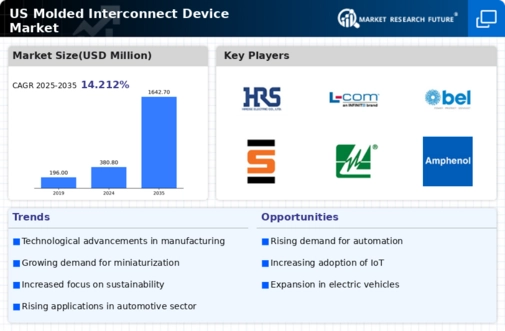Focus on Cost Reduction
Cost reduction remains a pivotal driver in the molded interconnect-device market. Manufacturers are increasingly seeking ways to lower production costs while maintaining quality and performance. This focus on cost efficiency is leading to the adoption of molded interconnect devices, which can streamline assembly processes and reduce the number of components required in electronic devices. By minimizing material waste and labor costs, companies can enhance their profit margins. As a result, the molded interconnect-device market is likely to see sustained growth as businesses prioritize cost-effective solutions in their production strategies.
Increased Investment in R&D
Investment in research and development (R&D) is a significant driver for the molded interconnect-device market. Companies are allocating substantial resources to innovate and develop new materials and technologies that enhance the performance of molded interconnect devices. This focus on R&D is crucial as it enables manufacturers to stay competitive in a rapidly evolving market. The US government has also been supportive of technological advancements through various funding initiatives, which further stimulates growth in this sector. As R&D efforts continue to yield new solutions, the molded interconnect-device market is expected to expand, catering to the evolving needs of various industries.
Growth in Automotive Electronics
The molded interconnect-device market is poised for growth due to the increasing integration of electronics in the automotive sector. As vehicles become more technologically advanced, the demand for reliable and efficient interconnect solutions rises. The automotive electronics market is projected to reach $300 billion by 2025, with molded interconnect devices playing a crucial role in enhancing vehicle functionality. Features such as advanced driver-assistance systems (ADAS) and infotainment systems require sophisticated interconnect solutions, thereby propelling the molded interconnect-device market. This trend indicates a shift towards more electronic components in vehicles, further driving market growth.
Rising Demand for Consumer Electronics
The molded interconnect-device market is significantly influenced by the rising demand for consumer electronics. With the proliferation of smartphones, tablets, and wearable devices, manufacturers are seeking innovative solutions to enhance device performance while minimizing size. The market for consumer electronics in the US is expected to reach $400 billion by 2026, which directly correlates with the growth of the molded interconnect-device market. As companies strive to meet consumer expectations for compact and efficient devices, the need for advanced interconnect solutions becomes increasingly critical, thereby driving market expansion.
Technological Advancements in Manufacturing
The molded interconnect-device market is experiencing a surge due to rapid technological advancements in manufacturing processes. Innovations such as 3D printing and automated assembly lines enhance production efficiency and reduce costs. These advancements allow for the creation of more complex and compact designs, which are essential in various applications, including consumer electronics and automotive sectors. As manufacturers adopt these technologies, the market is projected to grow at a CAGR of approximately 8% over the next five years. This growth is driven by the increasing demand for high-performance devices that require intricate interconnections, thereby propelling the molded interconnect-device market forward.




















Leave a Comment